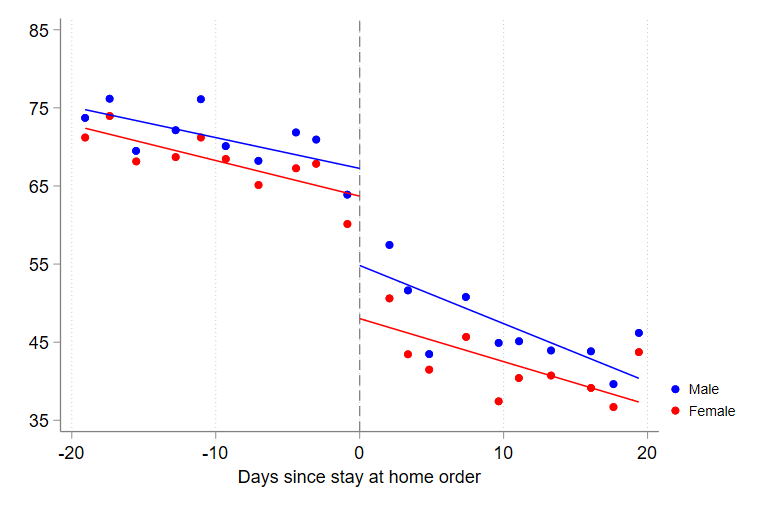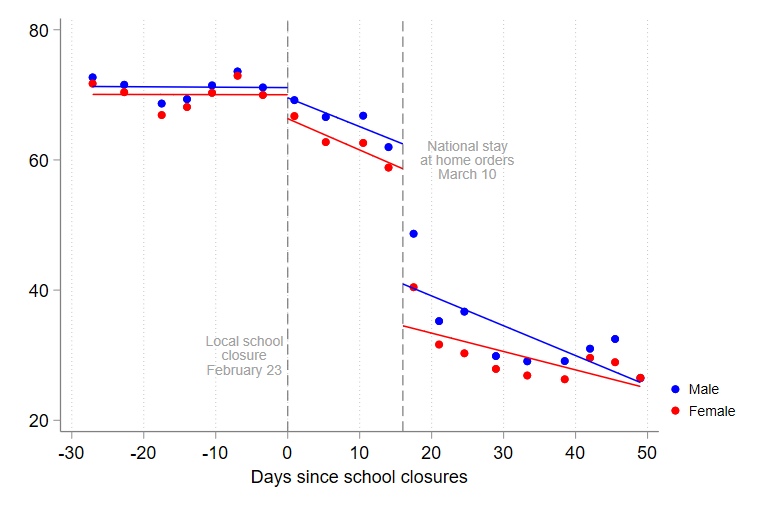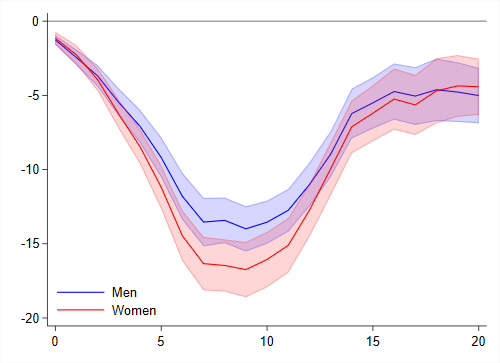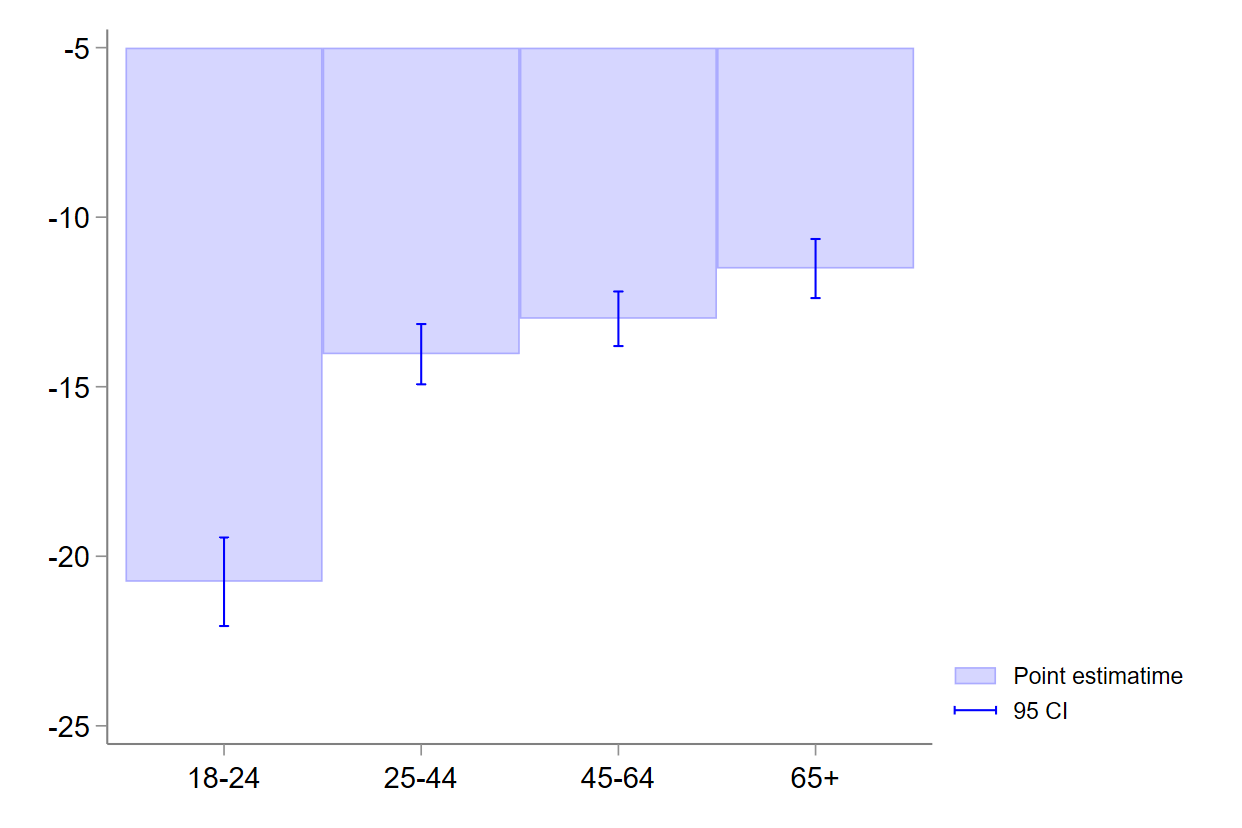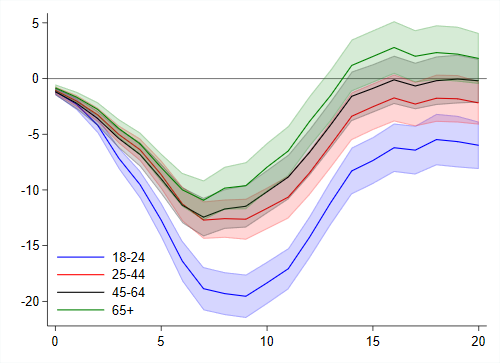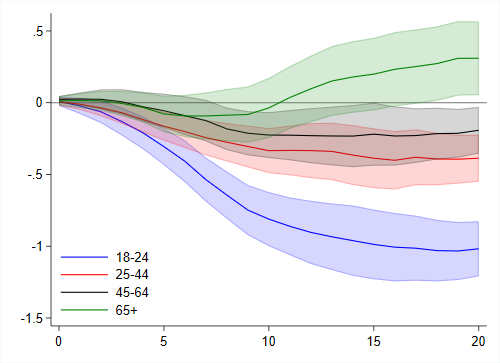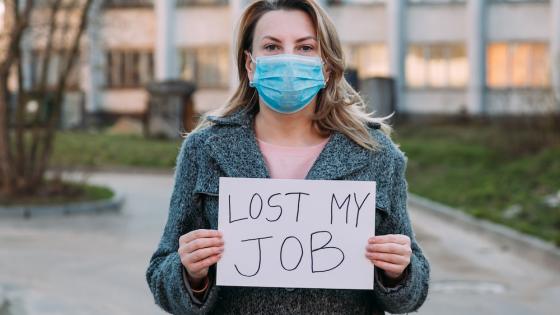The COVID-19 pandemic is having very unequal effects across people, hurting especially more vulnerable groups (Adams et al. 2020, Alon et al. 2020, Alstadsæter et al. 2020, Béland at al. 2020, Belot et al. 2020, Chetty et al. 2020, Glover et al. 2020, Hupkau and Petrangolo 2020, Sevilla and Smith 2020). This key aspect is overlooked in studies that examine mobility patterns during the pandemic because available indexes report average mobility levels for the entire population. We overcome this limitation using novel and confidential mobility indicators provided by Vodafone for Italy, Portugal, and Spain which are differentiated between gender and age groups (Caselli et al. 2020). These mobility indicators are anonymised and aggregated at the provincial (NUTS3) level, including a minimum group size of 50 people to protect privacy.
We document that lockdowns have an heterogenous impact on mobility across gender and age. Studying the effect of lockdowns is challenging because of endogeneity problems. To alleviate these concerns, we show that the results are robust using both regression discontinuity (RD) designs – which exploit high-frequency changes in mobility around lockdowns – and local projections which control for pre-existing mobility trends and for the severity of the country’s epidemic. We further strengthen identification by estimating the local projections using provinces less affected by COVID-19 and thus for which the adoption of national lockdowns was largely an exogenous event driven by outbreaks elsewhere in the country.
The local projections also allow us to examine the effects of rising COVID-19 cases on mobility, conditioning on the level of lockdowns stringency. This captures the extent to which people decide to voluntarily limit social interactions when the fear of contracting the virus becomes more acute. Examining this aspect is quite relevant since much of the public debate on the need for lockdowns has centred on whether people can autonomously change behaviour when infection risks arise.
Heterogeneous effects of lockdown measures on mobility across gender
The RD design shows that the adoption of stay-at-home orders led to a sharp drop in mobility for both genders, but the effect was more pronounced for women (Figure 1, top panel).1 Since stay-at-home orders generally coincided with school closures, the disproportionate impact on women’s mobility could reflect their preponderant role in childcare. Indeed, when we narrow the analysis to provinces that imposed school closures before stay-at-home orders, we see that the mobility gender gap opened already when schools closed (Figure 1, bottom panel).
Figure 1 Impact of stay-at-home orders and local school closures on mobility, by gender (age group 25-44, percent of people leaving home in a day)
Notes: The series are residualised with respect to province and day-of-the-week fixed effects.
The findings based on local projections corroborate the results of the RD analysis, showing that lockdowns had a disproportionate effect on women’s mobility. A full lockdown – including all measures used by governments during the pandemic – reduces the number of women leaving home after about a week by almost 17%, against an impact on men of about 13% (Figure 2).
Figure 2 Impact of a full lockdown on mobility, by gender (age group 25-44, percent)
Notes: The horizontal axis displays the number of days since the introduction of the lockdown. The shaded areas correspond to 90 percent confidence intervals.
Heterogeneous effects of lockdown measures on mobility across age
The RD design also shows that stay-at-home orders disproportionately reduced the mobility of working age people, especially those below 45 years of age (Figure 3, top panel). Local projections provide additional consistent evidence that lockdowns have a larger impact on younger cohorts (Figure 2, bottom panel).
Figure 3 Impact of stay-at-home orders and a full lockdown on mobility, by age group
a) Impact of a stay-at-home orders on mobility (percent)
b) Impact of a full lockdown on mobility (percent)
Notes: The horizontal axis in the bottom panel reports the number of days since the lockdown and the shaded areas correspond to 90% confidence intervals.
Does voluntary social distancing differ across age groups?
Younger cohorts are not only impacted more strongly by lockdowns, but they also tend to reduce their mobility more sharply in response to rising infections (Figure 4). Mobility remains instead broadly unchanged for people aged 65 and above when infections increase. This is consistent with survey evidence presented in Bordalo et al. (2020), who find that perceptions about the health risks posed by COVID-19 decline sharply with age, even though people aged 65+ face much greater health risks from COVID-19.2
Figure 4 Impact of doubling COVID-19 cases on mobility, by age group (percent)
Notes: The horizontal axis reports the number of days since the doubling of cases. The shaded areas correspond to 90 percent confidence intervals.
Conclusions
Using unique mobility indicators provided by Vodafone, we provide novel evidence about the disproportionate impact of lockdowns, especially school closures, on women’s mobility. This warns about a possible widening of gender inequality, as women may compromise their employment opportunities if they have to stay at home to care for children. Targeted policy intervention is required to support women during the pandemic, for example by offering parental leave to both men and women to encourage equal burden sharing in caring for children when schools are closed.
The analysis also shows that lockdowns tend to reduce the mobility of younger cohorts more strongly, a concerning finding because younger workers depend on labour income to sustain consumption and have less stable job contracts that are more likely to be terminated during a crisis. On the contrary, by containing infections, lockdowns benefit especially older people because they face much greater health risks from COVID-19. This underscores the urgency of an inter-generational social pact to compensate younger workers for the economic losses they face during lockdowns. This is needed not only to ensure greater fairness but also to preserve public support for lockdown measures to contain new epidemic waves.
This disaggregated analysis also is key for policymaking while the pandemic continues. The current dramatic resurgence of the number of COVID-19 cases in many countries is a reminder that the pandemic can suddenly intensify. Differently from the Spring, policymakers have more information on the relevant trade-offs. This study has shown that there is a significant heterogeneity across gender and age groups, highlighting the importance of a data-driven policy-making approach that contains the pandemic while protecting the most vulnerable groups in society.
Authors’ note: The views expressed herein are those of the authors and should not be attributed to the IMF, its Executive Board, or its management
References
Adams, A, T Boneva, M Golin, and C Rauh (2020), “Inequality in the Impact ofthe Coronavirus Shock: Evidence from Real Time Surveys”, CEPR Discussion Paper 14665 (VoxEU column available here).
Alon, T, M Doepke, J Olmstead-Rumsey, and M Tertilt (2020), “This Time It’s Different: The Role of Women’s Employment in a Pandemic Recession”, CEPR Discussion Paper 15149 (VoxEU column available here).
Alstadsæter, A, B Bratsberg, G Eielsen, W Kopczuk, S Markussen, O Raaum, and K Røed (2020), “The First Weeks of the Coronavirus Crisis: Who Got Hit, When and Why? Evidence from Norway”. NBER Working Paper 27131.
Béland, L-P, A Brodeur, and T Wright (2020), "The short-term economic consequences of Covid-19: exposure to disease, remote work and government response", IZA Discussion Paper No. 13159
Belot, M, S Choi, E Tripodi, E van den Broek-Altenburg, J C Jamison, and N W Papageorge (2020), “Unequal Consequences of COVID-19 across Age and Income: Representative Evidence from Six Countries”, IZA Discussion Paper No. 13366 (VoxEU column available here).
Caselli, F, F Grigoli, D Sandri, and A Spilimbergo (2020), “Mobility under the COVID-19 Pandemic: Asymmetric Effects across Gender and Age”, Covid Economics 64.
Chetty, R, J N Friedman, N Hendren, and M Stepner (2020), “How Did COVID-19 and Stabilization Policies Affect Spending and Employment? A New Real-Time Economic Tracker Based on Private Sector Data”, NBER Working Paper No. 27431.
Glover, A, J Heathcote, D Krueger, and J-V Rios-Rull (2020), “Health versus Wealth: On the Distributional Effects of Controlling a Pandemic”, CEPR Discussion Paper 14606 (VoxEU column available here).
Hupkau, C, and B Petrongolo (2020), “Work, Care and Gender during the Covid-19 Crisis”, Centre for Economic Performance, Paper No. 002, London School of Economics and Political Science (VoxEU column available at https://voxeu.org/article/covid-19-and-gender-gaps-latest-evidence-and-l...).
Sevilla, A and S Smith (2020), “Baby Steps: The Gender Division of Childcare during the COVID19 Pandemic”, Covid Economics 23 (VoxEU column available here).
Endnotes
1 We focus on people aged between 25–44 as individuals in this age group are more likely to have young children and thus being more affected by school closures.
2 The fact that younger generations seem more sensitive to the fear factor – measured as doubling COVID-19 cases – could also reflect that younger generations use more media and social media which emphasise the danger.






